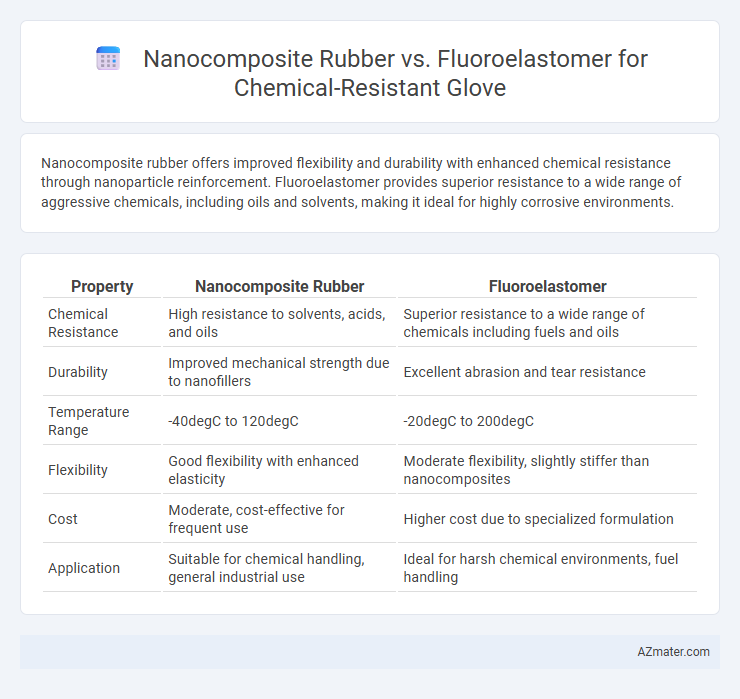Nanocomposite rubber offers improved flexibility and durability with enhanced chemical resistance through nanoparticle reinforcement. Fluoroelastomer provides superior resistance to a wide range of aggressive chemicals, including oils and solvents, making it ideal for highly corrosive environments.
Table of Comparison
| Property | Nanocomposite Rubber | Fluoroelastomer |
|---|---|---|
| Chemical Resistance | High resistance to solvents, acids, and oils | Superior resistance to a wide range of chemicals including fuels and oils |
| Durability | Improved mechanical strength due to nanofillers | Excellent abrasion and tear resistance |
| Temperature Range | -40degC to 120degC | -20degC to 200degC |
| Flexibility | Good flexibility with enhanced elasticity | Moderate flexibility, slightly stiffer than nanocomposites |
| Cost | Moderate, cost-effective for frequent use | Higher cost due to specialized formulation |
| Application | Suitable for chemical handling, general industrial use | Ideal for harsh chemical environments, fuel handling |
Introduction to Chemical-Resistant Glove Materials
Nanocomposite rubber and fluoroelastomers are advanced materials used in chemical-resistant gloves, offering superior protection against aggressive solvents, oils, and acids. Nanocomposite rubber incorporates nanoparticles into a polymer matrix, enhancing mechanical strength and chemical resistance compared to conventional rubber. Fluoroelastomers, composed of fluorine-containing polymers, provide exceptional resistance to a wide range of chemicals, extreme temperatures, and oxidative environments, making them ideal for high-performance protective gloves.
Overview of Nanocomposite Rubber
Nanocomposite rubber incorporates nanoscale fillers such as clay, carbon nanotubes, or silica to enhance mechanical strength, chemical resistance, and durability, making it highly effective for chemical-resistant gloves. These nanofillers improve barrier properties by creating tortuous pathways that reduce permeation of hazardous chemicals compared to traditional elastomers. The advanced molecular structure of nanocomposite rubber results in superior flexibility and abrasion resistance, offering enhanced protection and comfort in demanding chemical handling environments.
Overview of Fluoroelastomer
Fluoroelastomer gloves offer exceptional chemical resistance due to their unique fluorine-containing polymer structure, providing superior protection against oils, fuels, and aggressive solvents. These gloves maintain durability and flexibility in extreme temperatures and harsh environments, making them ideal for industrial applications involving hazardous chemicals. Compared to nanocomposite rubber, fluoroelastomers excel in resistance to permeation and degradation, ensuring longer service life and enhanced safety in chemical handling.
Chemical Resistance Comparison
Nanocomposite rubber exhibits enhanced chemical resistance due to its uniform dispersion of nanoparticles, providing superior barrier properties against various solvents and corrosive chemicals. Fluoroelastomer gloves offer outstanding resistance to a wide range of aggressive chemicals, including oils, fuels, and acids, with remarkable thermal stability and low permeability. Comparing chemical resistance, fluoroelastomers generally outperform nanocomposite rubber in extreme chemical exposure scenarios, while nanocomposite rubber provides cost-effective protection for moderate chemical handling.
Mechanical Properties and Durability
Nanocomposite rubber exhibits superior tensile strength and abrasion resistance compared to fluoroelastomer, resulting in enhanced mechanical performance under rigorous conditions. Fluoroelastomer gloves provide exceptional chemical resistance but generally have lower elongation at break and reduced resistance to mechanical wear. The integration of nanofillers in nanocomposite rubber significantly improves tear resistance and durability, making it more suitable for high-impact and repetitive-use environments.
Comfort and Flexibility in Glove Applications
Nanocomposite rubber offers superior flexibility and enhanced comfort in chemical-resistant gloves due to its lightweight structure and excellent elasticity, allowing greater dexterity during extended use. Fluoroelastomer gloves provide robust chemical resistance but tend to be stiffer, which can reduce wearer comfort and limit flexibility in precision tasks. Choosing nanocomposite rubber improves user experience by combining chemical protection with soft, flexible material properties ideal for prolonged glove applications.
Cost-Effectiveness and Production Considerations
Nanocomposite rubber offers a cost-effective solution for chemical-resistant gloves due to its lower raw material expenses and simpler manufacturing processes compared to fluoroelastomers, which require specialized curing and higher-priced fluorinated compounds. Production considerations favor nanocomposite rubber as it enables faster cycle times and easier scalability in glove manufacturing without compromising essential chemical resistance properties. Fluoroelastomer gloves provide superior resistance to aggressive chemicals but involve elevated production costs and complex quality control measures, impacting overall cost-efficiency.
Environmental Impact and Sustainability
Nanocomposite rubber gloves exhibit enhanced chemical resistance with lower environmental impact due to their use of eco-friendly fillers and reduced reliance on synthetic polymers, resulting in better biodegradability and recyclability compared to fluoroelastomer gloves. Fluoroelastomer gloves, while offering superior chemical resistance and durability, present sustainability challenges due to their complex fluorinated polymer chemistry, which hinders recycling and leads to persistent environmental pollutants. Selecting nanocomposite rubber gloves supports greener manufacturing processes and waste management, aligning with sustainable practices in chemical-resistant personal protective equipment (PPE).
Typical Industrial Applications
Nanocomposite rubber gloves exhibit enhanced mechanical strength and high resistance to oils, solvents, and abrasion, making them ideal for automotive manufacturing, oil and gas handling, and heavy chemical processing industries. Fluoroelastomer gloves provide superior chemical resistance against strong acids, ketones, and hydrocarbons, commonly used in pharmaceutical production, aerospace fuel handling, and laboratory environments. Both materials offer chemical resistance, but nanocomposite rubber excels in abrasion-heavy tasks while fluoroelastomers perform best in environments with aggressive chemical exposure.
Choosing the Right Material for Chemical-Resistant Gloves
Nanocomposite rubber offers enhanced mechanical strength and improved chemical resistance through the integration of nanoparticles, making it suitable for gloves exposed to aggressive solvents and oils. Fluoroelastomers provide exceptional resistance to a wide range of chemicals, including fuels, acids, and alkalis, with excellent heat and weather durability, ideal for industrial applications requiring long service life. Selecting the right material involves assessing the specific chemical exposure, temperature range, and durability requirements to ensure optimal protection and glove performance.

Infographic: Nanocomposite rubber vs Fluoroelastomer for Chemical-resistant glove
 azmater.com
azmater.com